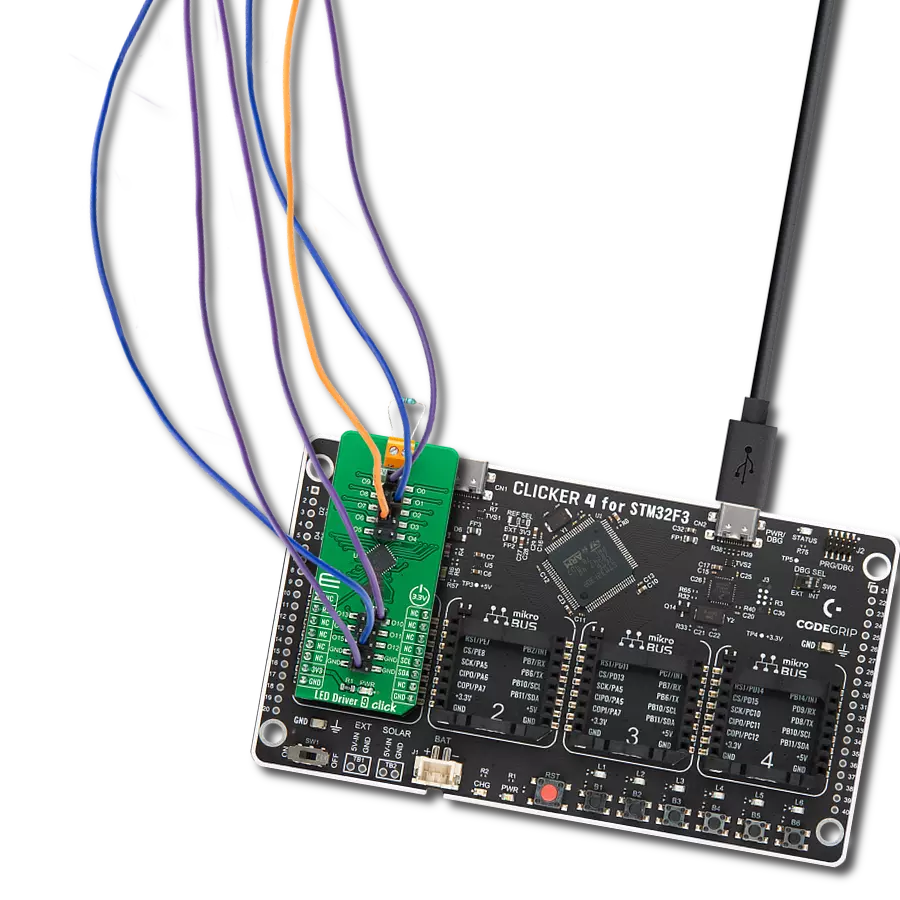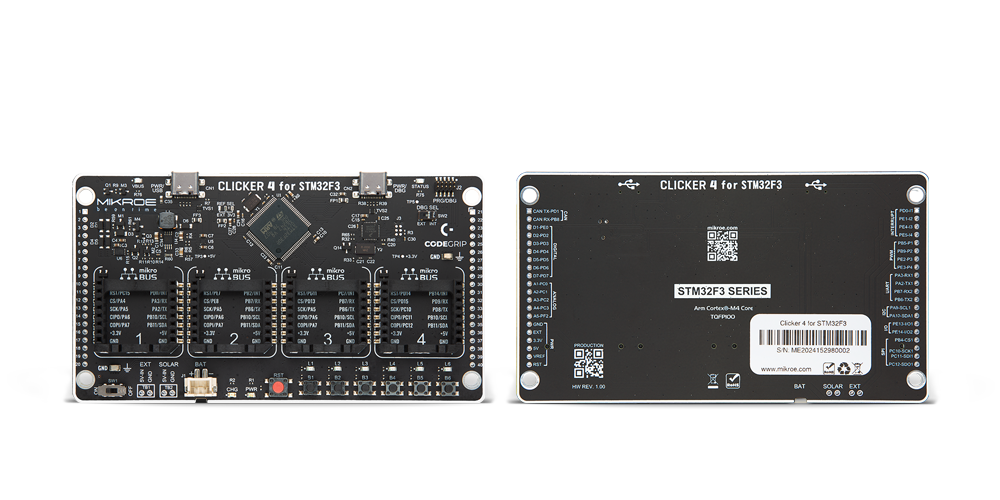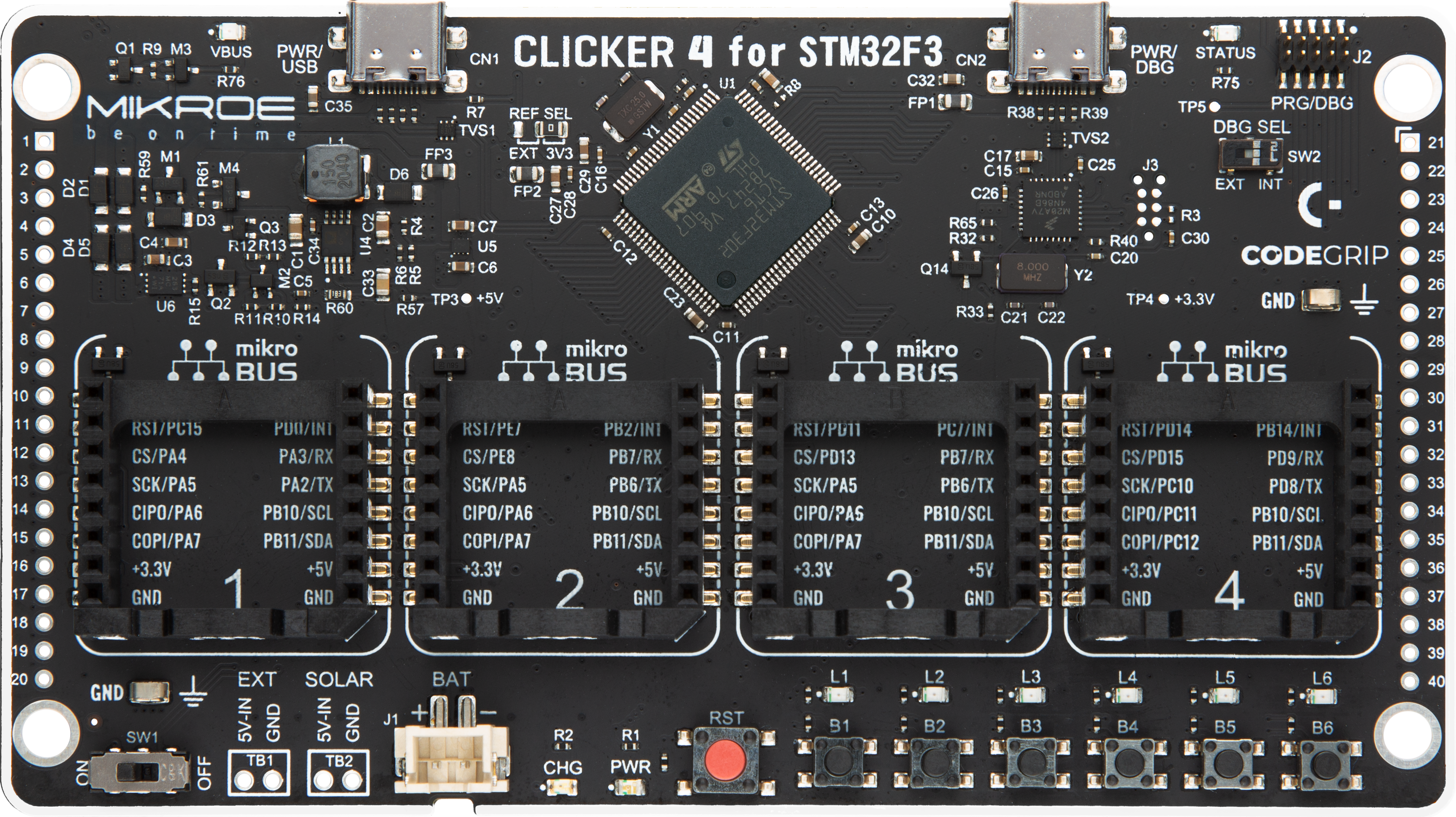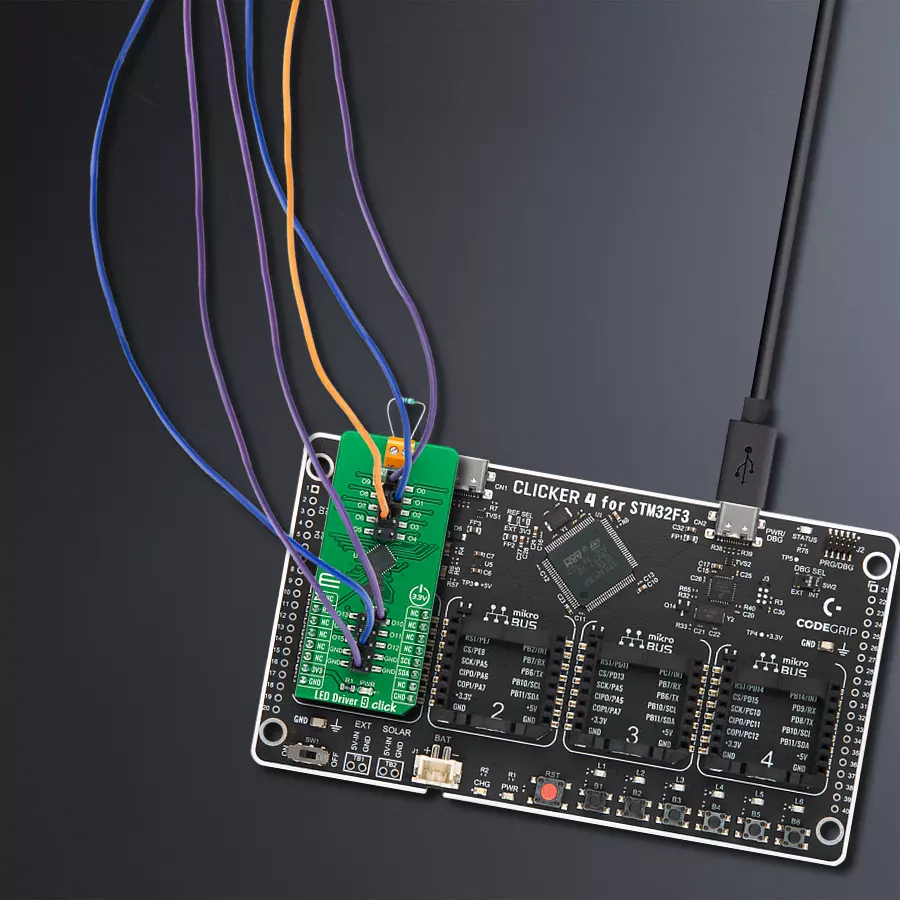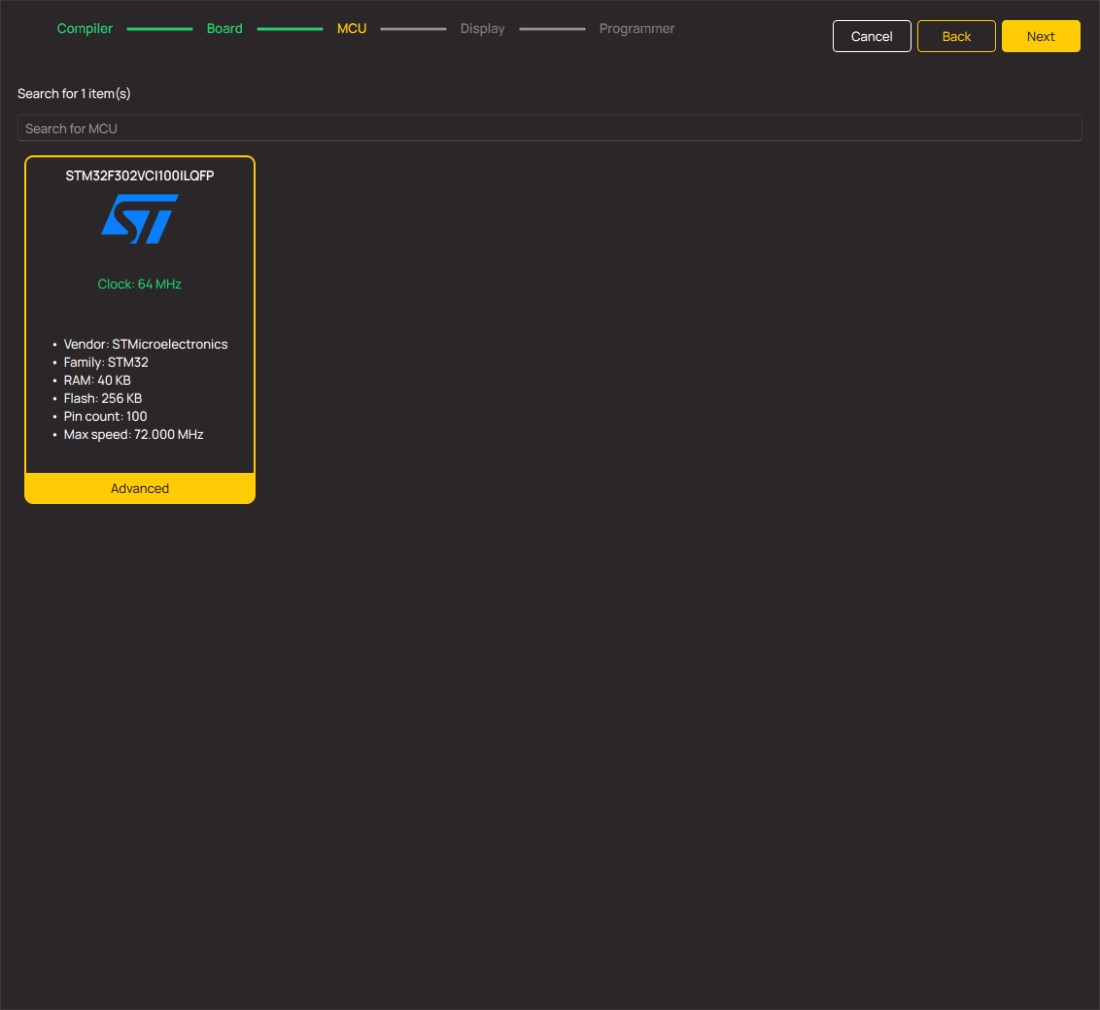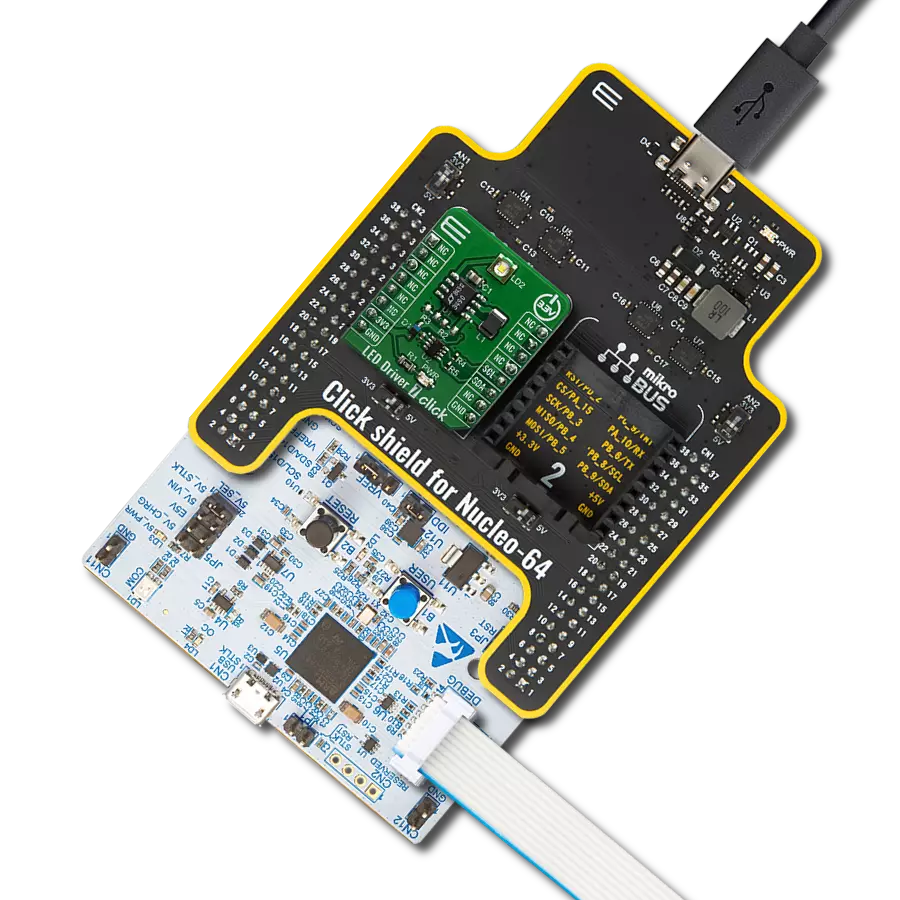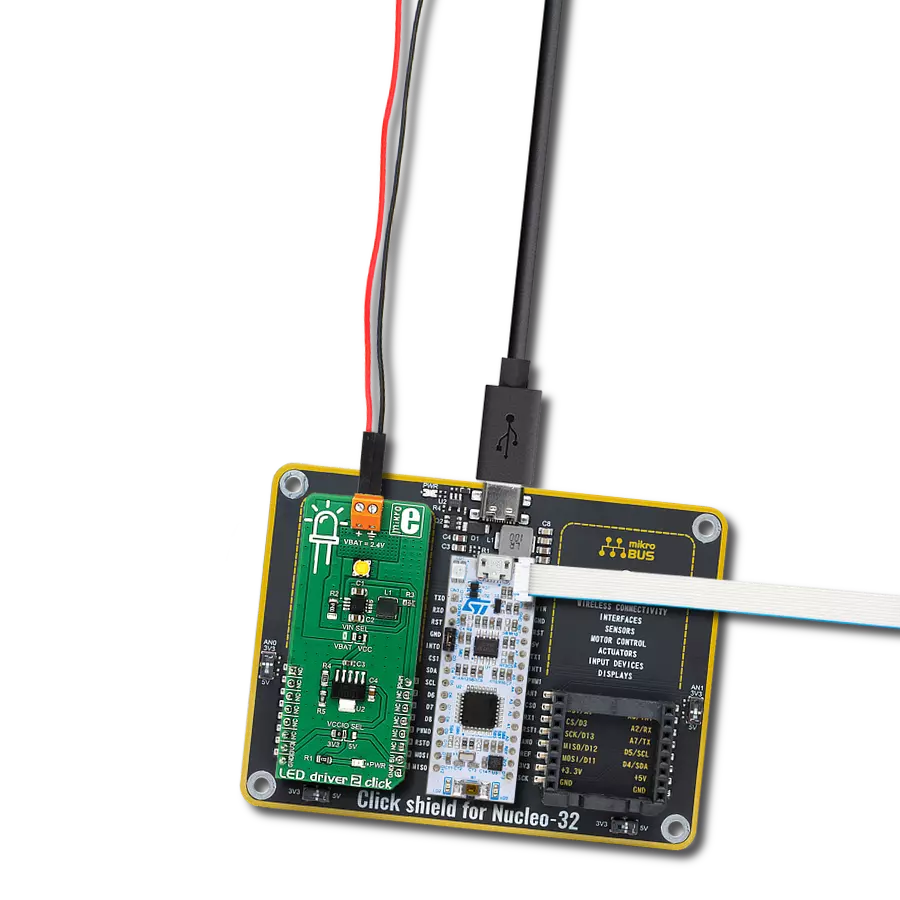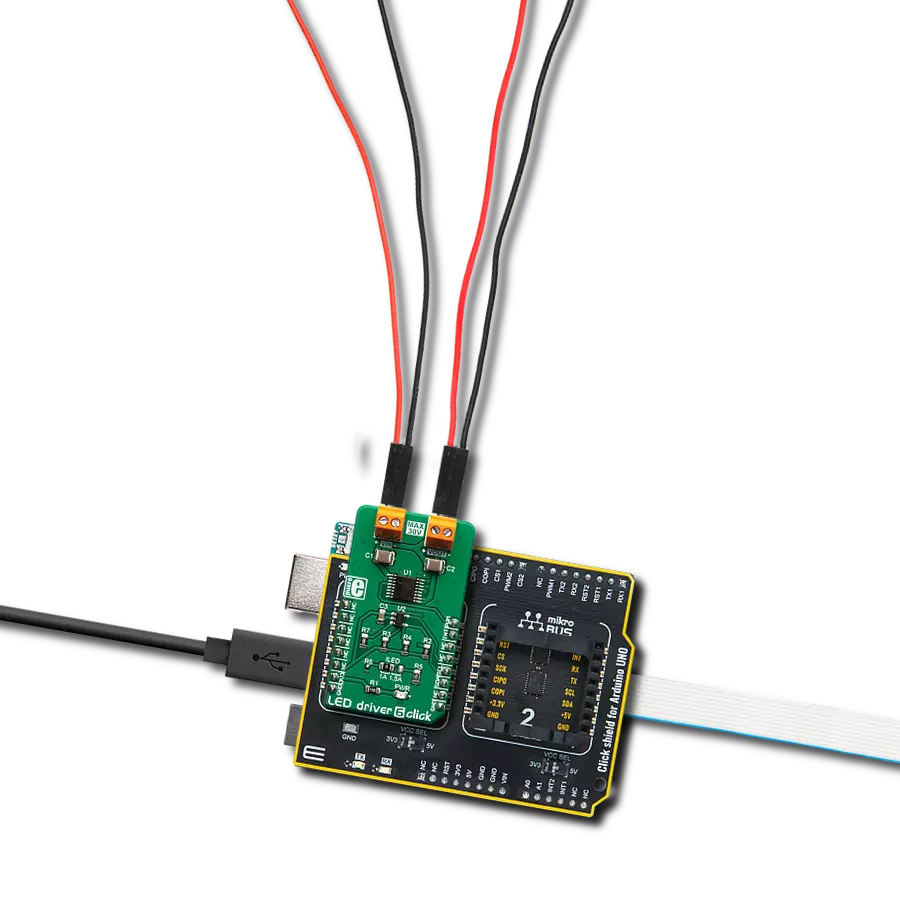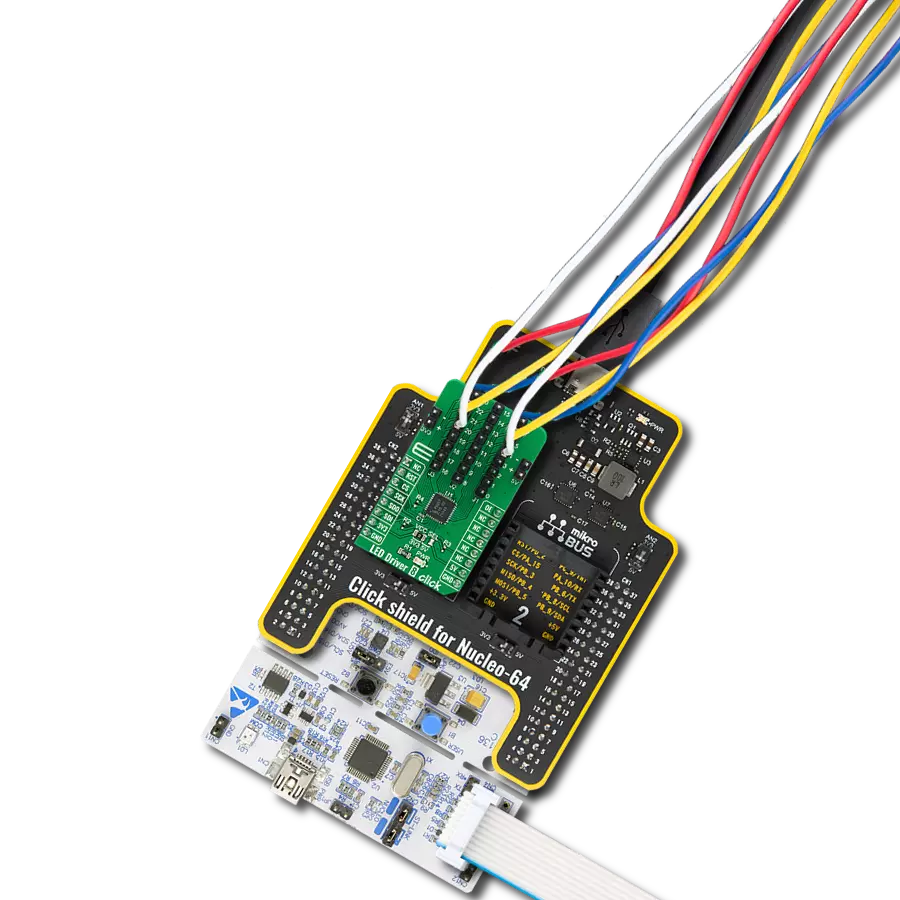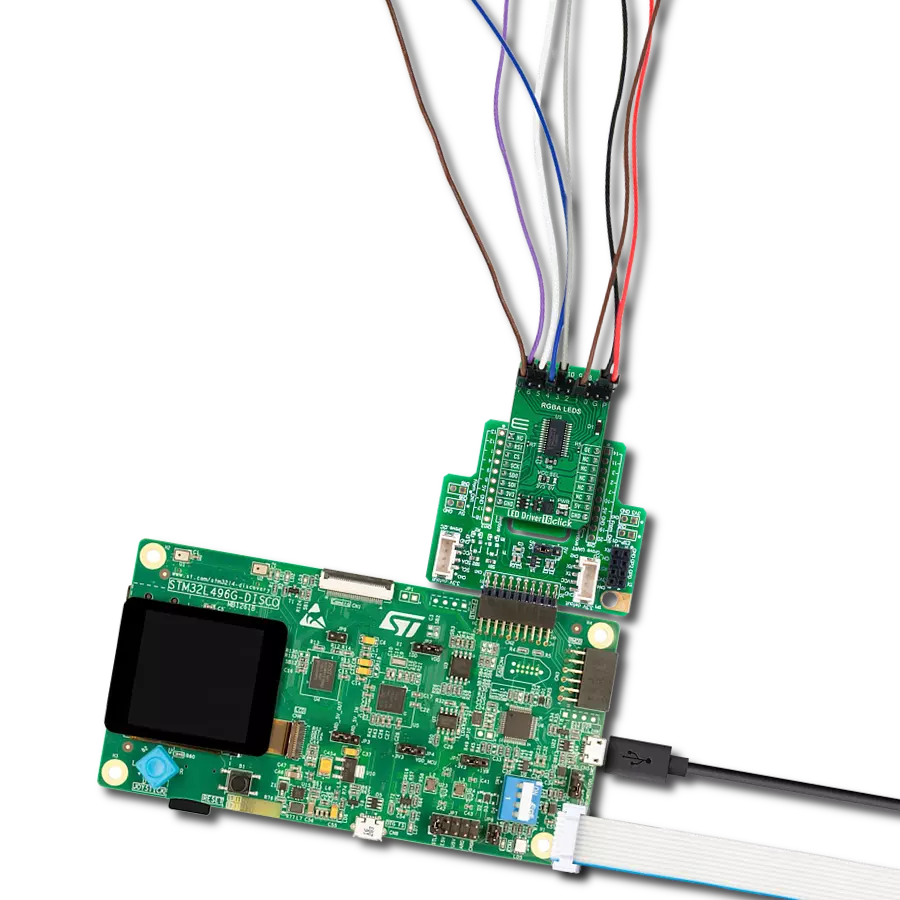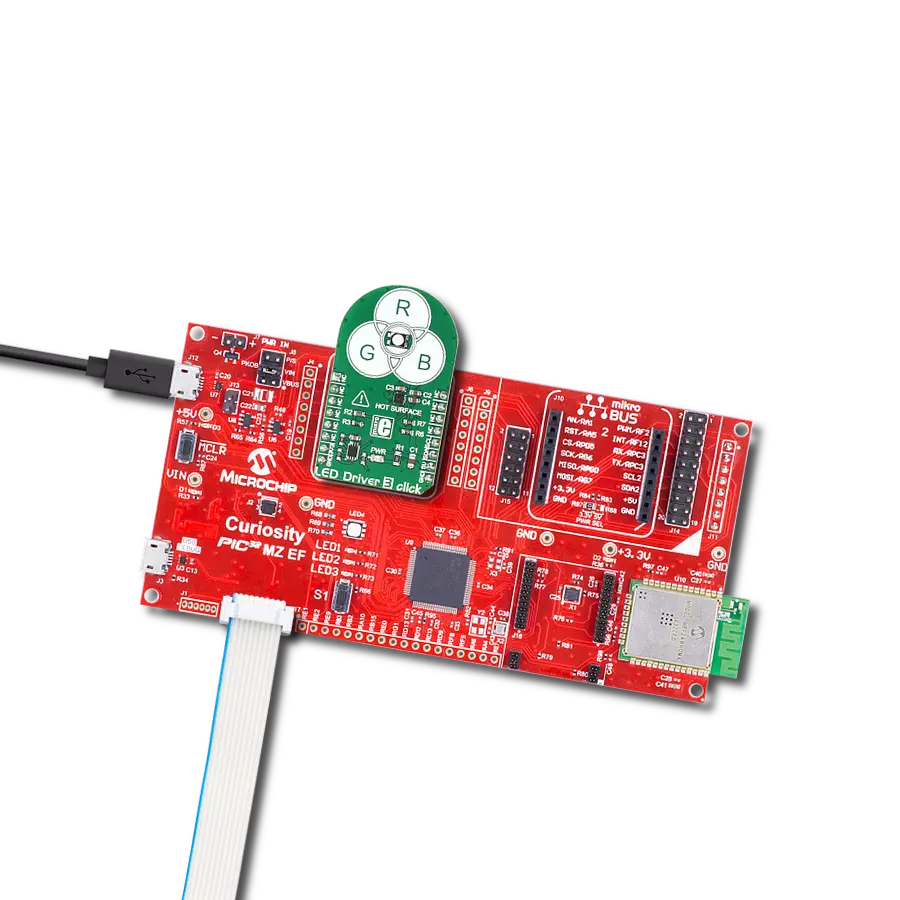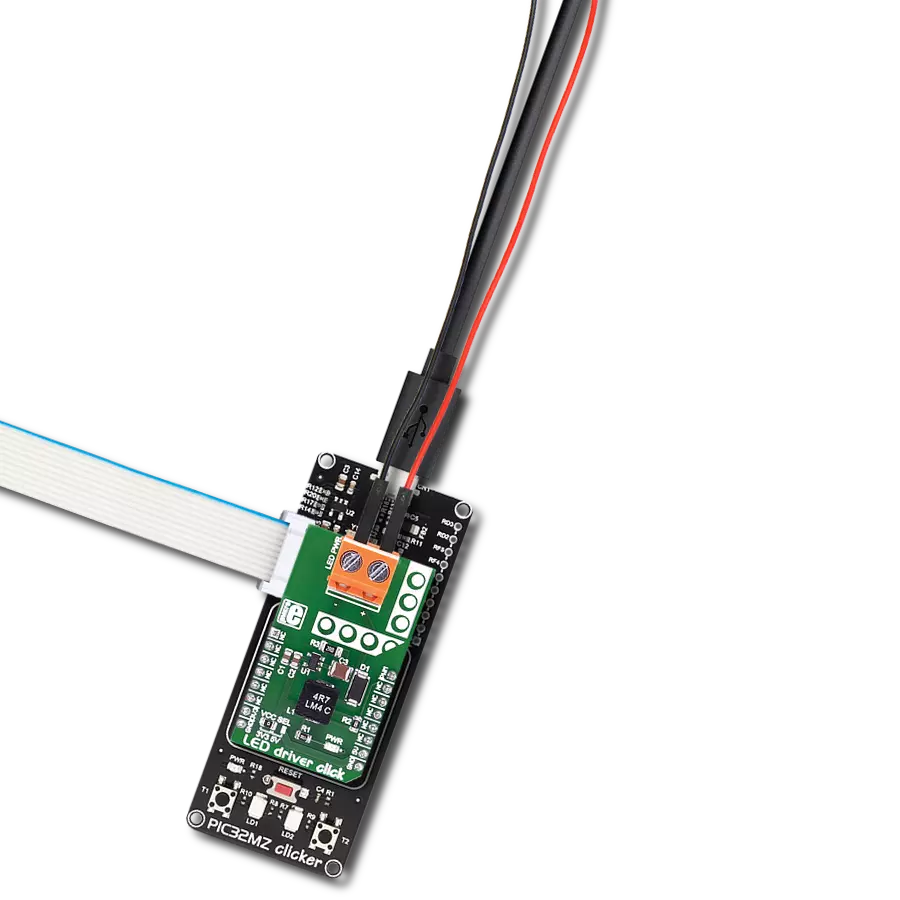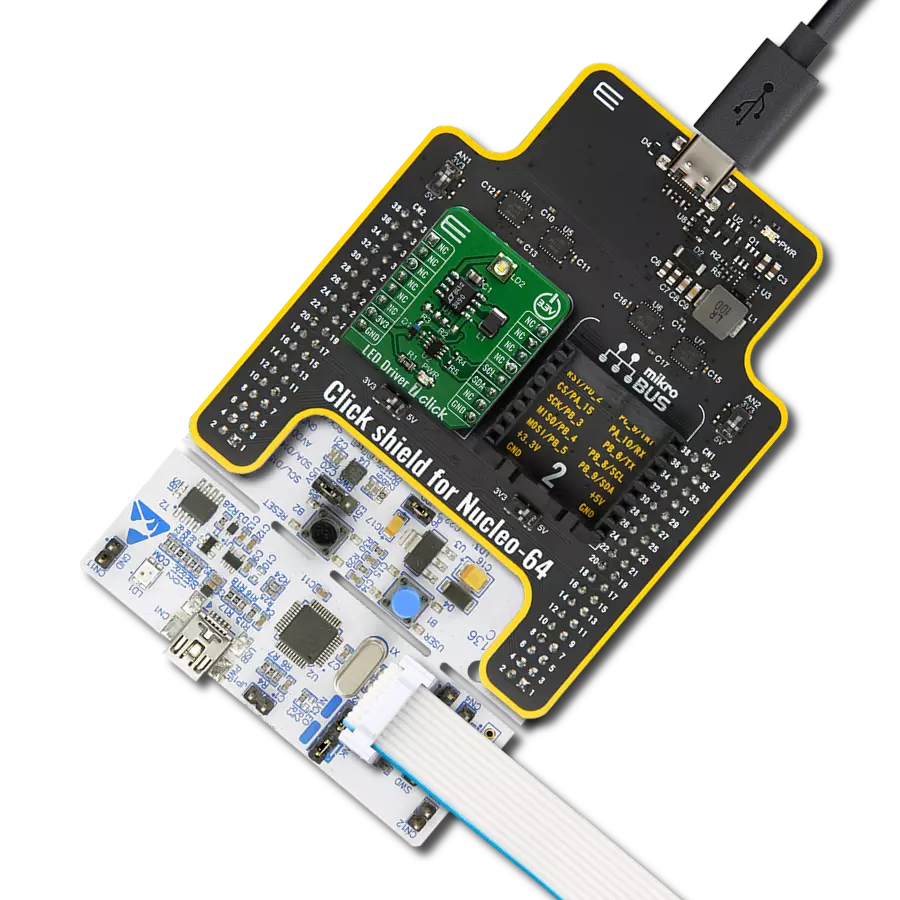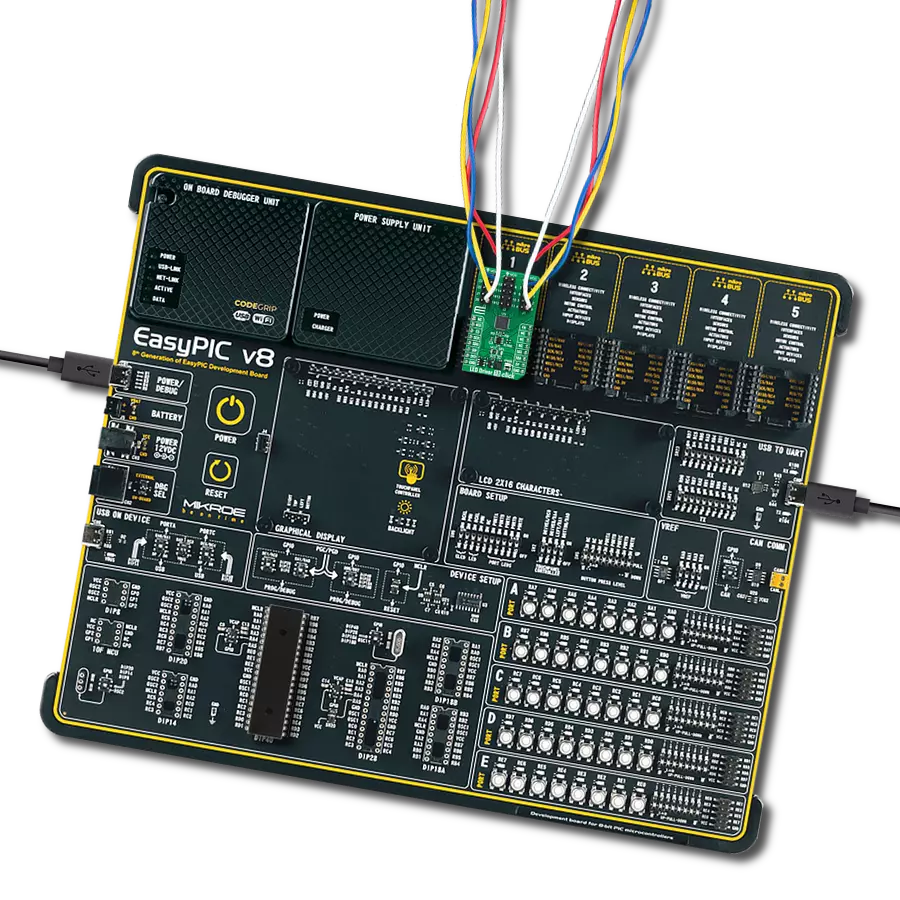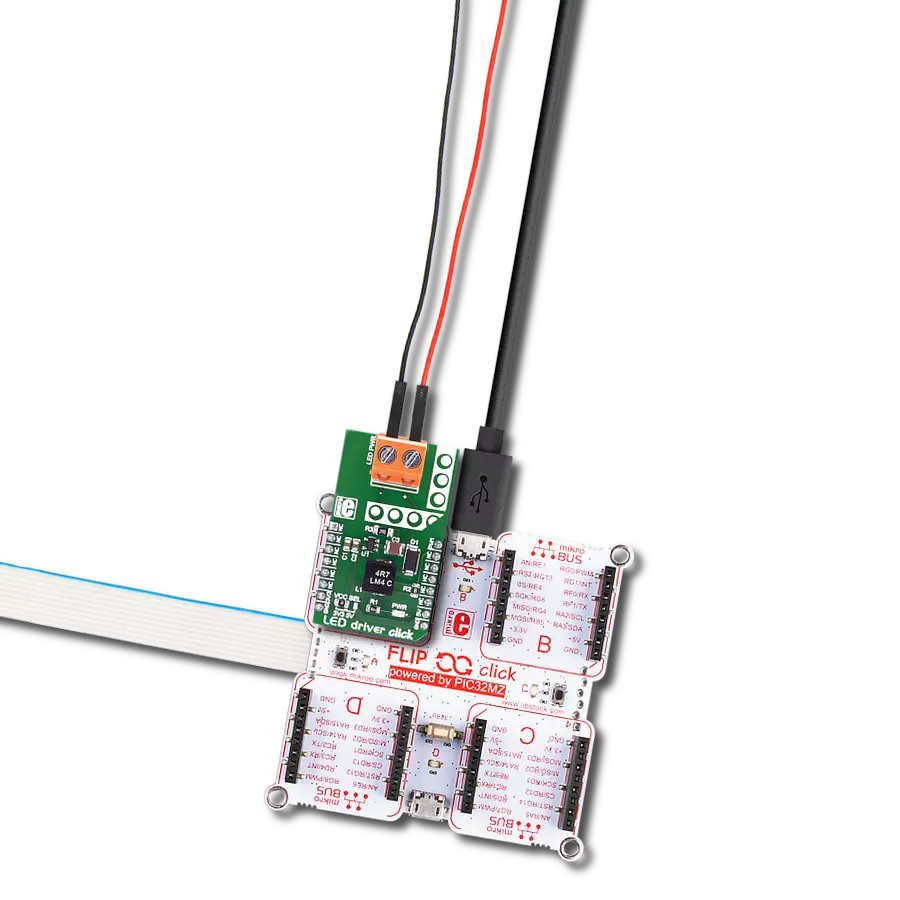Enhance user experience in your electronic projects with our LED driver's capability to deliver reliable and aesthetically pleasing lighting effects
A
A
Hardware Overview
How does it work?
LED Driver 9 Click is based on the TLC59116, an I2C bus-controlled 16-channel LED driver optimized for red/green/blue/amber (RGBA) color mixing and backlight application from Texas Instruments. It operates within a VCC supply voltage range where its outputs are 17V tolerant. Each LED output, 16 LED drivers presented on two 2x5 male headers, with a maximum output current of 120mA per channel, is programmable at OFF and ON state and has programmable individual LED brightness with group dimming and blinking. Each LED output has its individual PWM controller, which allows each LED to be set at a specific brightness value. An additional 8-bit resolution (256 steps) group PWM controller has a fixed frequency of
190Hz and an adjustable frequency between 24Hz to once every 10.73 seconds, with an adjustable duty cycle from 0% to 99.6%. LED Driver 9 Click communicates with MCU using a standard I2C 2-Wire interface, with a clock frequency up to 100kHz in the Standard, 400kHz in the Fast, and 1MHz in the Fast Mode Plus. The Software Reset feature allows the MCU to perform a reset of the TLC59116 through the I2C bus, identical to the Power-On Reset (POR) that initializes the registers to their default state, causing the outputs to be set high, which means that the LEDs are OFF. This allows a quick reconfiguring of all device registers to the same condition. Also, this Click board™ has a Reset pin routed to the RST pin on the
mikroBUS™ socket, which holds registers in their default states until the RST pin is set to a logic high state. At the top of this Click board™, there is also a terminal labeled Rext used to connect an external resistor to set the LED current. The TLC59116 scales up the reference current set by the external resistor to sink the output current at each output port. This Click board™ can be operated only with a 3.3V logic voltage level. The board must perform appropriate logic voltage level conversion before using MCUs with different logic levels. Also, it comes equipped with a library containing functions and an example code that can be used as a reference for further development.
Features overview
Development board
Clicker 4 for STM32F3 is a compact development board designed as a complete solution, you can use it to quickly build your own gadgets with unique functionalities. Featuring a STM32F302VCT6, four mikroBUS™ sockets for Click boards™ connectivity, power managment, and more, it represents a perfect solution for the rapid development of many different types of applications. At its core, there is a STM32F302VCT6 MCU, a powerful microcontroller by STMicroelectronics, based on the high-
performance Arm® Cortex®-M4 32-bit processor core operating at up to 168 MHz frequency. It provides sufficient processing power for the most demanding tasks, allowing Clicker 4 to adapt to any specific application requirements. Besides two 1x20 pin headers, four improved mikroBUS™ sockets represent the most distinctive connectivity feature, allowing access to a huge base of Click boards™, growing on a daily basis. Each section of Clicker 4 is clearly marked, offering an intuitive and clean interface. This makes working with the development
board much simpler and thus, faster. The usability of Clicker 4 doesn’t end with its ability to accelerate the prototyping and application development stages: it is designed as a complete solution which can be implemented directly into any project, with no additional hardware modifications required. Four mounting holes [4.2mm/0.165”] at all four corners allow simple installation by using mounting screws. For most applications, a nice stylish casing is all that is needed to turn the Clicker 4 development board into a fully functional, custom design.
Microcontroller Overview
MCU Card / MCU
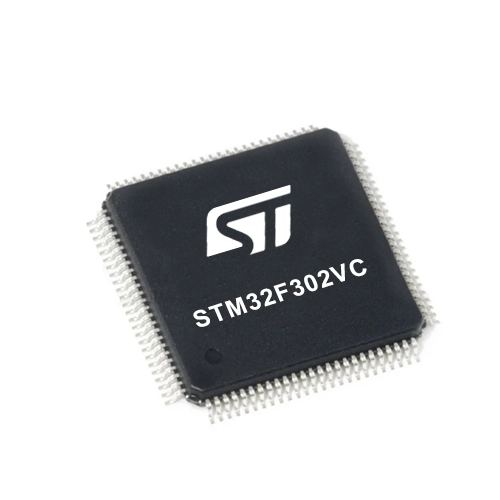
Architecture
ARM Cortex-M4
MCU Memory (KB)
256
Silicon Vendor
STMicroelectronics
Pin count
100
RAM (Bytes)
40960
Used MCU Pins
mikroBUS™ mapper
Take a closer look
Click board™ Schematic

Step by step
Project assembly
Software Support
Library Description
This library contains API for LED Driver 9 Click driver.
Key functions:
leddriver9_ledout_state- This function configures the LEDOUTx registers from the defined config structureleddriver9_set_pwm- This function sets the PWM duty cycle on selected ledout channelleddriver9_set_dimmer_pwm- This function sets the group PWM duty cycle ( GRPPWM ) which can be used for dimming already set PWM channels.
Open Source
Code example
The complete application code and a ready-to-use project are available through the NECTO Studio Package Manager for direct installation in the NECTO Studio. The application code can also be found on the MIKROE GitHub account.
/*!
* @file main.c
* @brief LEDDriver9 Click example
*
* # Description
* This app demonstrates the configuration and control
* of the LED Driver 9 Click board resulting in a nice
* breathing effect.
*
* The demo application is composed of two sections :
*
* ## Application Init
* The initialization configures the UART LOG and I2C
* drivers and adjusts the Led Driver 9 Click general
* register settings.
*
* ## Application Task
* The application task is a simple breathing effect on
* all LED out channels.
*
* @author Stefan Nikolic
*
*/
#include "board.h"
#include "log.h"
#include "leddriver9.h"
static leddriver9_t leddriver9;
static log_t logger;
static leddriver9_mode_reg_t dev_reg = { 0 };
static leddriver9_output_state_t output_state = { 0 };
static float max_duty = 20;
static float min_duty = 0;
static float duty_gradient = 0.1;
const uint8_t breathing_speed = 5;
void mode1_register_settings ( void );
void mode2_register_settings ( void );
void led_output_state ( void );
void application_init ( void ) {
log_cfg_t log_cfg; /**< Logger config object. */
leddriver9_cfg_t leddriver9_cfg; /**< Click config object. */
/**
* Logger initialization.
* Default baud rate: 115200
* Default log level: LOG_LEVEL_DEBUG
* @note If USB_UART_RX and USB_UART_TX
* are defined as HAL_PIN_NC, you will
* need to define them manually for log to work.
* See @b LOG_MAP_USB_UART macro definition for detailed explanation.
*/
LOG_MAP_USB_UART( log_cfg );
log_init( &logger, &log_cfg );
log_info( &logger, " Application Init " );
// Click initialization.
leddriver9_cfg_setup( &leddriver9_cfg );
LEDDRIVER9_MAP_MIKROBUS( leddriver9_cfg, MIKROBUS_1 );
err_t init_flag = leddriver9_init( &leddriver9, &leddriver9_cfg );
if ( init_flag == I2C_MASTER_ERROR ) {
log_error( &logger, " Application Init Error. " );
log_info( &logger, " Please, run program again... " );
for ( ; ; );
}
leddriver9_default_cfg( &leddriver9 );
log_info( &logger, " Application Task " );
mode1_register_settings( );
mode2_register_settings( );
Delay_ms ( 100 );
led_output_state( );
Delay_ms ( 100 );
}
void application_task ( void ) {
float duty_cnt = min_duty;
while ( duty_cnt <= max_duty ) {
leddriver9_set_pwm( &leddriver9, LEDDRIVER9_CHANNEL0, duty_cnt );
leddriver9_set_pwm( &leddriver9, LEDDRIVER9_CHANNEL1, duty_cnt );
leddriver9_set_pwm( &leddriver9, LEDDRIVER9_CHANNEL2, duty_cnt );
leddriver9_set_pwm( &leddriver9, LEDDRIVER9_CHANNEL3, duty_cnt );
leddriver9_set_pwm( &leddriver9, LEDDRIVER9_CHANNEL4, duty_cnt );
leddriver9_set_pwm( &leddriver9, LEDDRIVER9_CHANNEL5, duty_cnt );
leddriver9_set_pwm( &leddriver9, LEDDRIVER9_CHANNEL6, duty_cnt );
leddriver9_set_pwm( &leddriver9, LEDDRIVER9_CHANNEL7, duty_cnt );
leddriver9_set_pwm( &leddriver9, LEDDRIVER9_CHANNEL8, duty_cnt );
leddriver9_set_pwm( &leddriver9, LEDDRIVER9_CHANNEL9, duty_cnt );
leddriver9_set_pwm( &leddriver9, LEDDRIVER9_CHANNEL10, duty_cnt );
leddriver9_set_pwm( &leddriver9, LEDDRIVER9_CHANNEL11, duty_cnt );
leddriver9_set_pwm( &leddriver9, LEDDRIVER9_CHANNEL12, duty_cnt );
leddriver9_set_pwm( &leddriver9, LEDDRIVER9_CHANNEL13, duty_cnt );
leddriver9_set_pwm( &leddriver9, LEDDRIVER9_CHANNEL14, duty_cnt );
leddriver9_set_pwm( &leddriver9, LEDDRIVER9_CHANNEL15, duty_cnt );
duty_cnt += duty_gradient;
Delay_ms ( breathing_speed );
}
while ( duty_cnt > min_duty ) {
leddriver9_set_pwm( &leddriver9, LEDDRIVER9_CHANNEL0, duty_cnt );
leddriver9_set_pwm( &leddriver9, LEDDRIVER9_CHANNEL1, duty_cnt );
leddriver9_set_pwm( &leddriver9, LEDDRIVER9_CHANNEL2, duty_cnt );
leddriver9_set_pwm( &leddriver9, LEDDRIVER9_CHANNEL3, duty_cnt );
leddriver9_set_pwm( &leddriver9, LEDDRIVER9_CHANNEL4, duty_cnt );
leddriver9_set_pwm( &leddriver9, LEDDRIVER9_CHANNEL5, duty_cnt );
leddriver9_set_pwm( &leddriver9, LEDDRIVER9_CHANNEL6, duty_cnt );
leddriver9_set_pwm( &leddriver9, LEDDRIVER9_CHANNEL7, duty_cnt );
leddriver9_set_pwm( &leddriver9, LEDDRIVER9_CHANNEL8, duty_cnt );
leddriver9_set_pwm( &leddriver9, LEDDRIVER9_CHANNEL9, duty_cnt );
leddriver9_set_pwm( &leddriver9, LEDDRIVER9_CHANNEL10, duty_cnt );
leddriver9_set_pwm( &leddriver9, LEDDRIVER9_CHANNEL11, duty_cnt );
leddriver9_set_pwm( &leddriver9, LEDDRIVER9_CHANNEL12, duty_cnt );
leddriver9_set_pwm( &leddriver9, LEDDRIVER9_CHANNEL13, duty_cnt );
leddriver9_set_pwm( &leddriver9, LEDDRIVER9_CHANNEL14, duty_cnt );
leddriver9_set_pwm( &leddriver9, LEDDRIVER9_CHANNEL15, duty_cnt );
duty_cnt -= duty_gradient;
Delay_ms ( breathing_speed );
}
}
int main ( void )
{
/* Do not remove this line or clock might not be set correctly. */
#ifdef PREINIT_SUPPORTED
preinit();
#endif
application_init( );
for ( ; ; )
{
application_task( );
}
return 0;
}
void mode1_register_settings ( void ) {
dev_reg.mode_1.ALLCALL = 0;
dev_reg.mode_1.SUB3 = 0;
dev_reg.mode_1.SUB2 = 0;
dev_reg.mode_1.SUB1 = 0;
dev_reg.mode_1.OSC = 0;
leddriver9_mode1_reg_write( &leddriver9, &dev_reg );
}
void mode2_register_settings ( void ) {
dev_reg.mode_2.OCH = 0;
dev_reg.mode_2.DMBLNK = 0;
dev_reg.mode_2.EFCLR = 0;
leddriver9_mode2_reg_write( &leddriver9, &dev_reg );
}
void led_output_state ( void ) {
output_state.LEDOUT0.LDR0 = LEDDRIVER9_GROUP;
output_state.LEDOUT0.LDR1 = LEDDRIVER9_GROUP;
output_state.LEDOUT0.LDR2 = LEDDRIVER9_GROUP;
output_state.LEDOUT0.LDR3 = LEDDRIVER9_GROUP;
output_state.LEDOUT1.LDR4 = LEDDRIVER9_GROUP;
output_state.LEDOUT1.LDR5 = LEDDRIVER9_GROUP;
output_state.LEDOUT1.LDR6 = LEDDRIVER9_GROUP;
output_state.LEDOUT1.LDR7 = LEDDRIVER9_GROUP;
output_state.LEDOUT2.LDR8 = LEDDRIVER9_GROUP;
output_state.LEDOUT2.LDR9 = LEDDRIVER9_GROUP;
output_state.LEDOUT2.LDR10 = LEDDRIVER9_GROUP;
output_state.LEDOUT2.LDR11 = LEDDRIVER9_GROUP;
output_state.LEDOUT3.LDR12 = LEDDRIVER9_GROUP;
output_state.LEDOUT3.LDR13 = LEDDRIVER9_GROUP;
output_state.LEDOUT3.LDR14 = LEDDRIVER9_GROUP;
output_state.LEDOUT3.LDR15 = LEDDRIVER9_GROUP;
leddriver9_ledout_state( &leddriver9, &output_state );
}
// ------------------------------------------------------------------------ END
Additional Support
Resources
Category:LED Drivers
